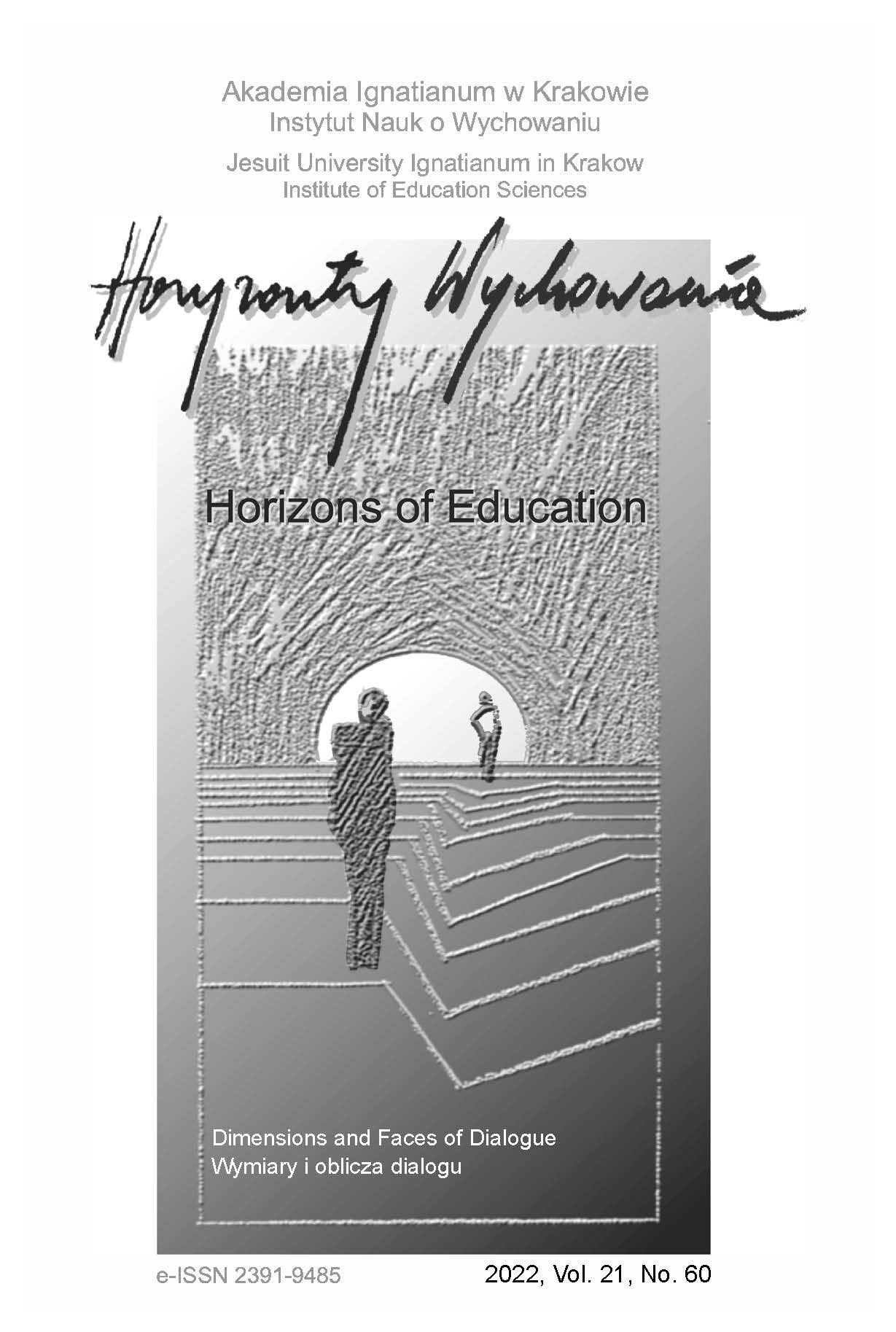Being Right or Builing Relationships? – positive discipline in the school classroom
Abstract
RESEARCH OBJECTIVE: The goal is to point out the importance of establishing relationships between teachers and students in view of selected research, to outline the tenets of J. Nelsen’s Positive Discipline and to signal the ways of establishing relationships in the school classroom according to this method.
THE RESEARCH PROBLEM AND METHODS: The main problem was formulated as follows: What is the importance of building relationships between students and teachers, and what are the possibilities of applying Positive Discipline in the school classroom? The research is based on the analytical-synthetic method, which was used to analyze the literature on psychology and pedagogy.
THE PROCESS OF ARGUMENTATION: The article refers to research conducted in Poland and other countries that shows the importance of relationships in the educational process, and also indicates the theoretical premises of Positive Discipline as an educational method. I also discuss the implications of this method for school practice.
RESEARCH RESULTS: Research done in many countries shows that good relationships at school translate into educational success for students. Children and adolescents are more willing to learn when they have a sense of belonging and importance, and when they feel that the teacher likes them. Therefore, Positive Discipline, which is based on the premise that teachers should develop children’s social competencies in addition to their academic knowledge and skills is worth implementing in schools to build a good atmosphere between students and teachers.
CONCLUSIONS, INNOVATIONS, RECOMMENDATIONS: Positive discipline is a method that is worth implementing in educational institutions when working with students of all ages. Recognizing the importance of interpersonal relations in the educational process, we should organize the space at school in such a way that it becomes a place where everyone satisfies the need for belonging and meaning, and where everyone has the right to make mistakes.
References
Babad, E. (1993). Teachers’ differential behavior. Educational Psychology Review, 5(4), 347-376.
Bauer, J. (2015). Co z tą szkołą? Siedem perspektyw dla uczniów, nauczycieli i rodziców (A. Lipiński, Trans.). Dobra Literatura.
Boszczyk, N. (2020). Dobre relacje w szkole. Warszawa: Wolters Kluwer.
Cichocki, A. (2009). Nauczyciele jako twórcy edukacyjnego klimatu klasy szkolnej. In J. Izdebska & J. Szymanowska (Eds.), Dziecko w zmieniającej się przestrzeni życia. Obrazy dzieciństwa (pp. 351-367). Trans Humana.
Crocker, W.J. (n.d.). Miejsce ludzi. Polska Akademia Oświaty. http://www.pao.edu.pl/onas/misja
Davis, E.A. (2006). Characterizing productive reflection among preservice elementary teachers: Seeing what matters. Teaching and Teacher Education, 22(3), 281-301.
Davis, H.A. (2003). Conceptualizing the role and influence of student–teacher relationships on children’s social and cognitive development. Educational Psychologist, 38(4), 207-234.
Davis, H.A. (2006). Exploring the contexts of relationship quality between middle school students and teachers. The Elementary School Journal, 106(3), 193-223.
Goleman, D. (1997). Inteligencja emocjonalna (A. Jankowski, Trans.). Media Rodzina.
Hamre, B.K, & Pianta, R.C (2005). Can instructional and emotional support in the first-grade classroom make a difference of children at risk of school failure? Child Development, 76(5), 949-967.
Hattie, J. (2015). Widoczne uczenie się dla nauczycieli. Jak maksymalizować siłę oddziaływania na uczenie się (Z. Janowska, Trans.). Warszawa: Centrum Edukacji Obywatelskiej.
Murray, C., & Malmgren, K. (2005). Implementing a teacher–student relationship program in a high-poverty urban school: Effects on social, emotional and academic adjustment and lessons learned. The Journal of School Psychology, 43(2), 137-152.
Nelsen, J. (2015). Pozytywna dyscyplina (A. Czechowska & A. Rosiak, Trans.). CoJaNaTo.
Okoń, W. (2001). Nowy słownik pedagogiczny. Wydawnictwo Akademickie „Żak”.
Osterman, K.F. (2000). Students’ need for belonging in the school community. Review of Educa- tional Research, 70(3), 323-367.
Ostrowska, K., & Surzykiewicz, J. (2005). Zachowania agresywne w szkole. Badania porównawcze 1997 i 2003. Centrum Metodyczne Pomocy Psychologiczno-Pedagogicznej.
Positive Discipline. (n.d.). About Positive Discipline. https://www.positivediscipline.com/ about-positive-discipline
Przewłocka, J. (2015). Klimat szkoły i jego znaczenie dla funkcjonowania uczniów w szkole. Raport o stanie badań. Instytut Badań Edukacyjnych. https://www.cen.lomza.pl/files/36300417/file
Redakcja MamaDu. (2018, September 7). Każde dziecko przynosi do szkoły dwa plecaki. Nauczyciele zapominają o tym drugim. MamaDu. https://mamadu. pl/138633,kazde-dziecko-przynosi-do-szkoly-dwa-plecaki-jeden-jest-niewidzialny
Sankowska, A. (n.d.). Pozytywna dyscyplina, skuteczna metoda wychowawcza. http://ppp8.pl/wp-content/uploads/2019/03/Pozytywna-dyscyplina-opr.-Anna-Sankowska.pdf
Sterna, D. (2016). Uczę się uczyć. Ocenianie kształtujące w praktyce. Warszawa: Centrum Edukacji Obywatelskiej.
Welskop, W. (2013). Komunikacja w relacji nauczyciel–uczeń a występowanie sytuacji kryzysowych w szkole. In P. Potejko (Ed.), Komunikacja w sytuacjach kryzysowych. 4 (pp. 166-173. Wydawnictwa i Szkolenia Opcjon. https://depot.ceon.pl/handle/123456789/3621
Copyright (c) 2022 HORIZONS OF EDUCATION

This work is licensed under a Creative Commons Attribution-NoDerivatives 4.0 International License.
Authors who publish in this journal agree to the following terms:
- Authors retain the copyright to their work while granting the journal the right of first publication. The work will be simultaneously licensed under a CC BY-ND license, which permits others to share the work with proper credit given to the author and the original publication in this journal.
- Authors may enter into additional, non-exclusive agreements for the distribution of the published version of the work (e.g., posting it in an institutional repository or publishing it in another journal), provided that the original publication in this journal is acknowledged.
We allow and encourage authors to share their work online (e.g., in institutional repositories or on personal websites) both before and during the submission process, as this can foster beneficial exchanges and lead to earlier and increased citations of the published work. (See The Effect of Open Access). We recommend using any of the following academic networking platforms:





